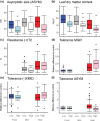Trait divergence and trade-offs among Brassicaceae species differing in elevational distribution
- PMID: 35779006
- PMCID: PMC9545065
- DOI: 10.1111/evo.14554
Trait divergence and trade-offs among Brassicaceae species differing in elevational distribution
Abstract
Species have restricted geographic distributions and the causes are still largely unknown. Temperature has long been associated with distribution limits, suggesting that there are ubiquitous constraints to the evolution of the climate niche. Here, we investigated the traits involved in such constraints by macroevolutionary comparisons involving 100 Brassicaceae species differing in elevational distribution. Plants were grown under three temperature treatments (regular frost, mild, regular heat) and phenotyped for phenological, morphological, and thermal resistance traits. Trait values were analyzed by assessing the effect of temperature and elevational distribution, by comparing models of evolutionary trajectories, and by correlative approaches to identify trade-offs. Analyses pointed to size, leaf morphology, and growth under heat as among the most discriminating traits between low- and high-elevation species, with high-elevation species growing faster under the occurrence of regular heat bouts, at the cost of reduced size. Mixed models and evolutionary models supported adaptive divergence for these traits, and correlation analysis indicated their involvement in moderate trade-offs. Finally, we found asymmetry in trait evolution, with evolvability across traits being 50% less constrained under regular frost. Overall, results suggest that trade-offs between traits under adaptive divergence contribute to the disparate distribution of species along the elevational gradient.
Keywords: Heat and frost stress; Ornstein-Uhlenbeck; macroevolution; phylogenetic signal; range limits; thermal niche.
© 2022 The Authors. Evolution published by Wiley Periodicals LLC on behalf of The Society for the Study of Evolution.
Conflict of interest statement
The authors declare no conflict of interest.
Figures


Similar articles
-
A review on trade-offs at the warm and cold ends of geographical distributions.Philos Trans R Soc Lond B Biol Sci. 2022 Apr 11;377(1848):20210022. doi: 10.1098/rstb.2021.0022. Epub 2022 Feb 21. Philos Trans R Soc Lond B Biol Sci. 2022. PMID: 35184594 Free PMC article. Review.
-
Niche breadth and elevational range size: a comparative study on Middle-European Brassicaceae species.Philos Trans R Soc Lond B Biol Sci. 2022 Mar 14;377(1846):20210005. doi: 10.1098/rstb.2021.0005. Epub 2022 Jan 24. Philos Trans R Soc Lond B Biol Sci. 2022. PMID: 35067087 Free PMC article.
-
Functional leaf traits indicate phylogenetic signals in forests across an elevational gradient in the central Himalaya.J Plant Res. 2021 Jul;134(4):753-764. doi: 10.1007/s10265-021-01289-1. Epub 2021 Apr 9. J Plant Res. 2021. PMID: 33837511
-
Temperature-stress resistance and tolerance along a latitudinal cline in North American Arabidopsis lyrata.PLoS One. 2015 Jun 25;10(6):e0131808. doi: 10.1371/journal.pone.0131808. eCollection 2015. PLoS One. 2015. PMID: 26110428 Free PMC article.
-
Patterns and drivers of intraspecific variation in avian life history along elevational gradients: a meta-analysis.Biol Rev Camb Philos Soc. 2016 May;91(2):469-82. doi: 10.1111/brv.12180. Epub 2015 Mar 12. Biol Rev Camb Philos Soc. 2016. PMID: 25765584 Review.
Cited by
-
A review on trade-offs at the warm and cold ends of geographical distributions.Philos Trans R Soc Lond B Biol Sci. 2022 Apr 11;377(1848):20210022. doi: 10.1098/rstb.2021.0022. Epub 2022 Feb 21. Philos Trans R Soc Lond B Biol Sci. 2022. PMID: 35184594 Free PMC article. Review.
-
Leaf traits divergence and correlations of woody plants among the three plant functional types on the eastern Qinghai-Tibetan Plateau, China.Front Plant Sci. 2023 Apr 3;14:1128227. doi: 10.3389/fpls.2023.1128227. eCollection 2023. Front Plant Sci. 2023. PMID: 37077644 Free PMC article.
References
-
- Aeschimann, D. , Lauber, K. , Moser, D.M. & Theurillat, J.‐P. (2004) Flora alpina. Haupt, Bern, Switzerland.
-
- Agrawal, A.A. , Conner, J.K. & Stinchcombe, J.R. (2004) Evolution of plant resistance and tolerance to frost damage. Ecol. Lett., 7, 1199–1208.
-
- Al‐Shehbaz, I.A. , Beilstein, M.A. & Kellogg, E.A. (2006) Systematics and phylogeny of the Brassicaceae (Cruciferae): an overview. Plant Syst. Evol., 259, 89–120.
-
- Beaulieu, J.M. , Jhwueng, D.C. , Boettiger, C. & O'Meara, B.C. (2012) Modelling stabilizing selection: expanding the Ornstein–Uhlenbeck model of adaptive evolution. Evolution; Internation Journal of Organic Evolution, 66, 2369–2383. - PubMed
